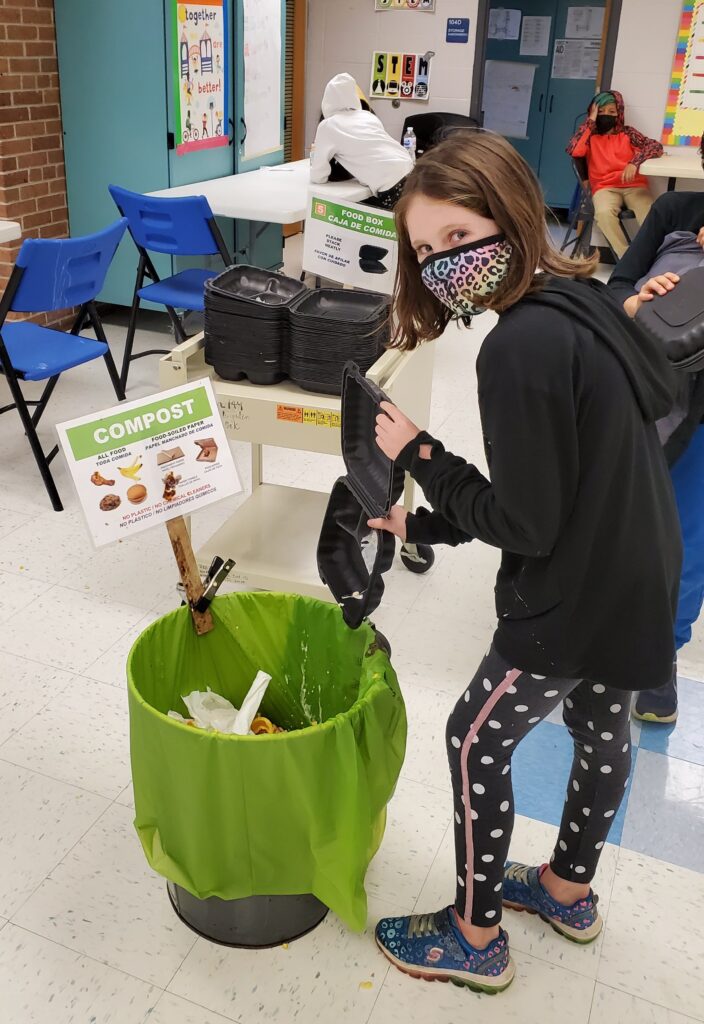
Determined to overcome pandemic challenges and interruptions, schools in SGA’s Zero Waste Schools-Lake County Program have made it a priority to get their zero waste lunchrooms back up and running. The Zero Waste Schools team at SGA created a 15-minute education video to teach/re-teach students the How & Why of going for zero waste to help get them started. Read on to hear how Red Oak, Oak Terrace, and Braeside Elementary Schools in North Shore School District 112 in Highland Park have made it happen.
Students and staff at Red Oak Elementary were eager to restart their program and are back to sorting liquids, recycling, and composting food scraps. The school now has two sorting lines instead of one to help with social distancing, and new parent volunteers have been impressed by students’ sorting savvy. Prior to the pandemic Red Oak used compostable trays, but, in order to accommodate the new COVID restrictions, they are temporarily serving lunches in plastic clamshells. While these clamshells aren’t accepted for recycling, simply stacking them has reduced the lunchtime garbage bags from 8 to only 2 per day.
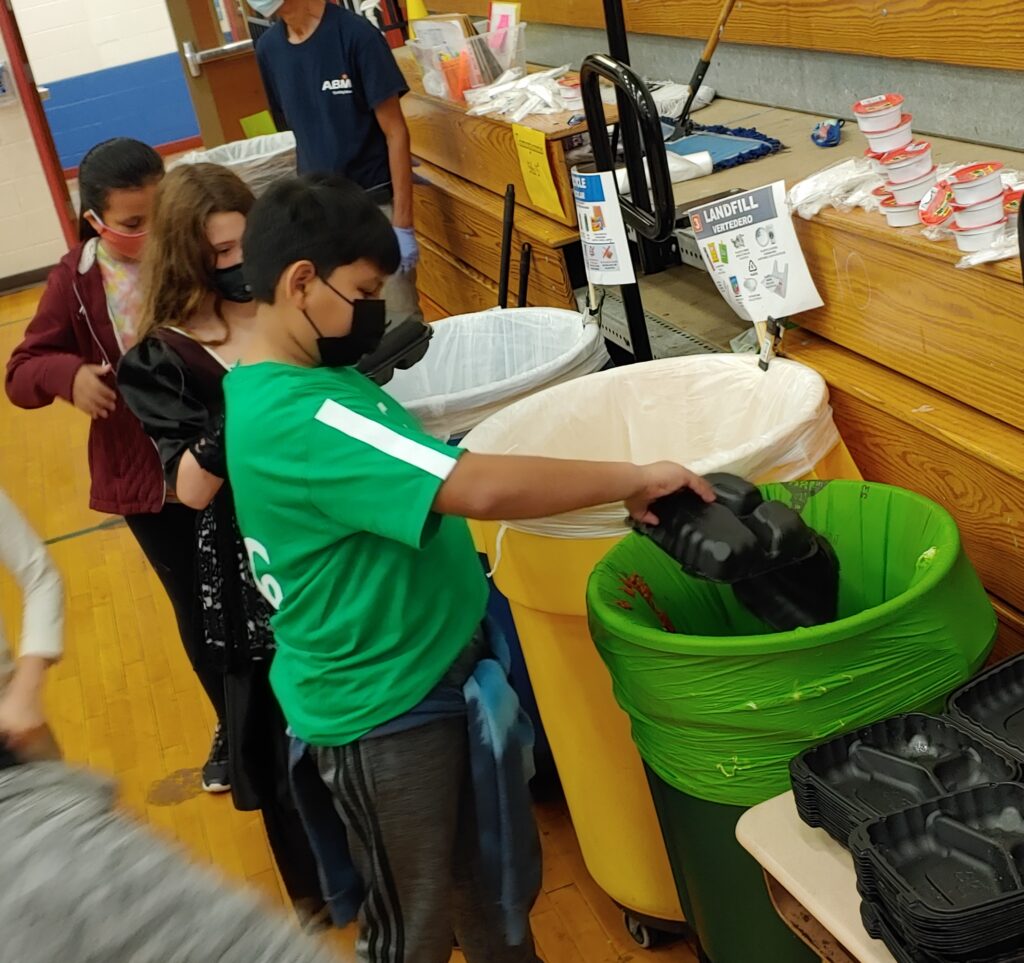
After restarting their recycling and composting routine just a few weeks ago, Oak Terrace Elementary, a school of 520 students, is now generating only about one bag of landfill trash per day. Although they’re currently unable to use the utensil and napkin dispensers they were using pre-pandemic, school leaders came up with a creative alternative: utensils and napkins are now available upon request, thus avoiding hundreds of utensils unnecessarily going to the landfill.
Sorting at Oak Terrace is a true community effort. Student Zero Waste Agents (ZWA) help the kindergarten and first grade students, and parents volunteer their time to provide additional support. “I like helping kids and doing good for the environment,” remarked one ZWA.
At Braeside Elementary, school lunch is ordered from a different local restaurant each day (both now and pre-pandemic), which makes for lots of extra packaging. Despite this added challenge for getting to zero waste, parent and student volunteers make sure that all students know what goes where. They remind students, “if in doubt, throw it out” in order to minimize contamination (things that don’t belong) of the different bins. One 4th grade helper shares, “I help zero waste because it is not good for the environment to waste this much food. We are trying to limit the amount of stuff we put in landfills, because if the landfills get too full, there will be nowhere to put our trash.”
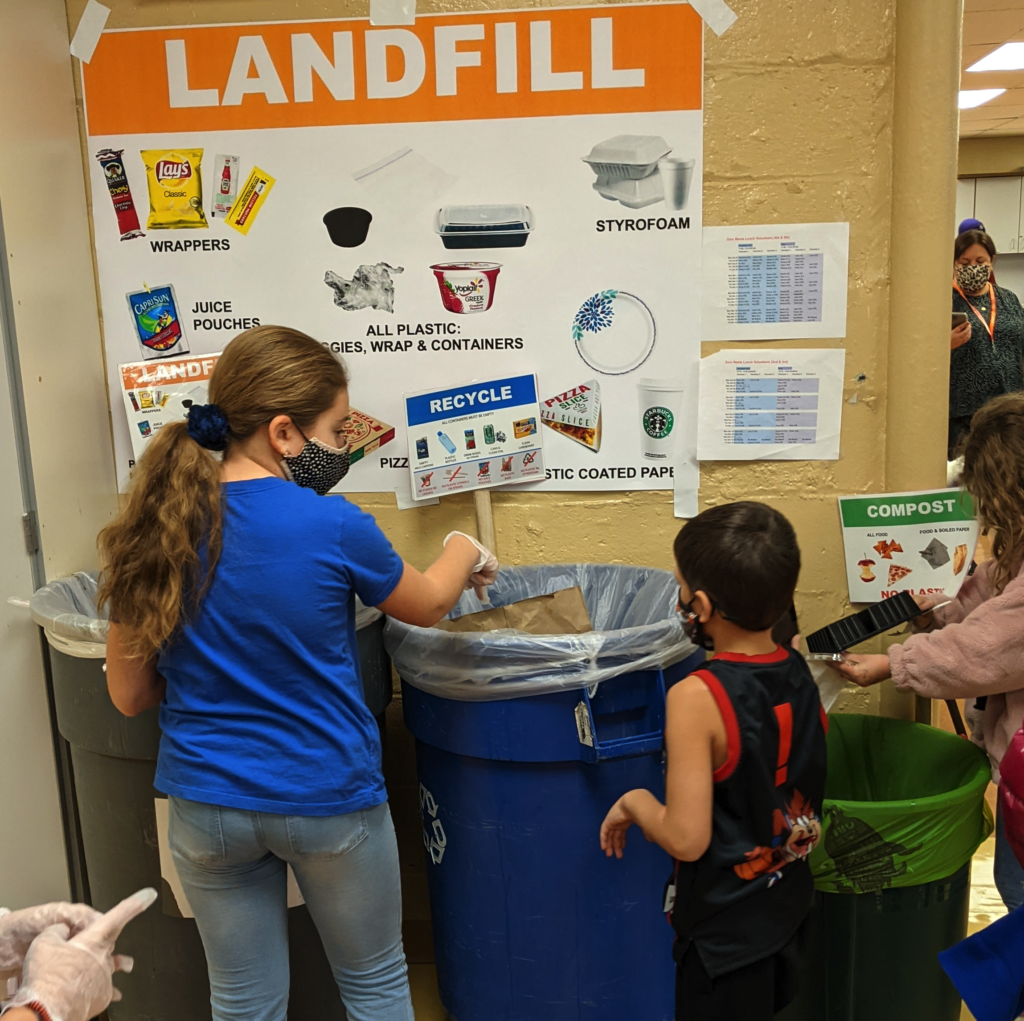
Students’ zero waste efforts have also made an impression on Braeside’s new principal, “The program helps students understand where their trash goes after it’s thrown away, ways to reduce the garbage they create, and how to be more environmentally conscious with what they discard. Through a simple process of sorting what is left over from their lunch, students take an active role in taking care of our planet, community, and school.”
Check out SGA’s Zero Waste Schools Toolkit so you can start your own school on a path to zero waste. The Zero Waste Schools-Lake County Program has received funding to expand to two additional public schools this year. Contact Susan Casey, susan@sevengenertionsahead.org, if your school is interested.
November 8, 2021
Use these signs as reference to create your own. Keep in mind that signs are most effective if they are color coded, use photos, show the most commonly used items in the lunchroom, and are placed at eye level. The order of collection containers and their corresponding signs is essential to the success of any sorting program. Consider using different colored bags in the collection containers to differentiate the waste streams. (See the Sorting Station section below for details about additional best practices for setting up a sorting station.)
Recycling: This set of signs is designed for schools that would like to recycle in the lunchroom. Lunchroom recycling requires a bucket or bin for collecting leftover liquid since all drink containers must be empty in order to be recycled. This set of signs also includes a sign for stacking trays. Stacking trays will greatly reduce the volume of landfill waste as well as the number of times the custodian needs to change the landfill bags.

Recycling & Commercial Composting: This set of signs is designed for schools that would like to recycle and do commercial composting. Lunchroom recycling requires a bucket or bin for collecting leftover liquid since all drink containers must be empty in order to be recycled. This set of signs also includes a sign for stacking trays. Stacking trays significantly reduces the volume they take up, as well as the number of times the custodian needs to change the landfill bags. If your trays are compostable, the stacked trays can be added to the compost bin at the end of each lunch period.

Recycling & Onsite Composting: This set of signs is designed for schools that would like to recycle and do onsite composting. Lunchroom recycling requires a bucket or bin for collecting leftover liquid since all drink containers must be empty in order to be recycled. This set of signs also includes a sign for stacking trays. Stacking trays significantly reduces the volume they take up, as well as the number of times the custodian needs to change the landfill bags.

Share table signs: Share tables are a great way to prevent good food from going to landfills. A share table is a place where students can place items from a school meal if they choose not to eat them. These items are then made available to other children who may want or need another serving during or after the meal service or they can be donated to an outside organization. Contact your local health department before implementing a share table or food donation program to find out if local health and food safety codes in your area allow these practices. See the section on share tables in this Toolkit for more information.
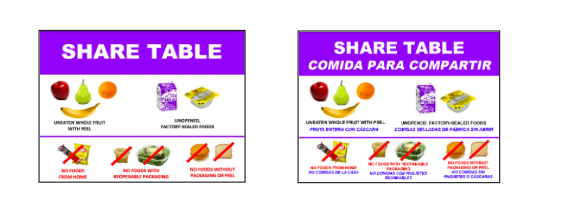
Share Table Signs with Milk
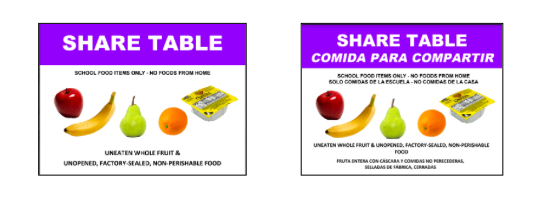
Share Table Sign no Milk
Kitchen sorting signs: Recycling, Landfill, and Commercial Composting:

Sample signs for classroom/hallway/office recycling:
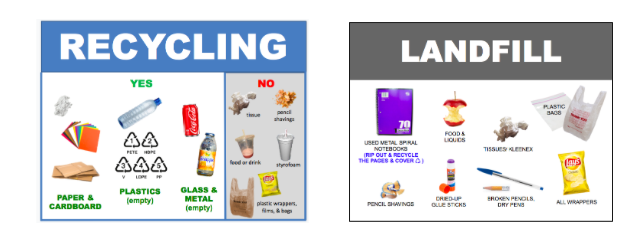
Option 1
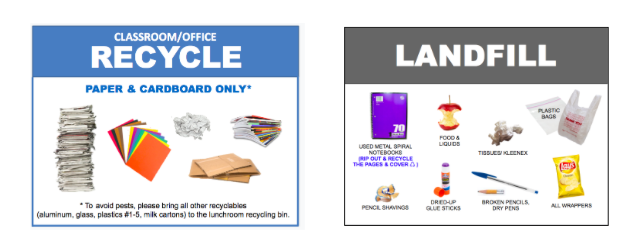
Option 2
Sign attachment method: A best practice for sign placement is to attach signs directly above the sorting bins. If your sorting bins are against a wall, then they can easily be taped to the wall. But if the bins need to be located away from walls, here is a low-cost method for attaching them. The only materials needed are small hand clamps (available at hardware stores for about $1 each) and rulers or wood shims (also available at hardware stores).
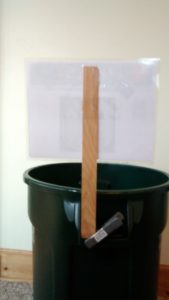
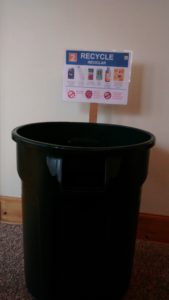
The purpose of a sorting station is to separate material streams (to separate recyclables from landfill trash, for example). Here are some best practices and things to consider when setting up a sorting station:
Sequence of bins
The sequence or order that bins are located within a sorting station is important to efficient sorting. It helps for students to form a line and move through the station in one direction.
Consider what students have on their lunch trays/lunch boxes and the most efficient way to get those materials sorted.
Here are some tips for sequencing bins:
• Locate the liquids bin at the front of the station so that students can empty unfinished drinks before they have the chance to spill them.
• Locate the recycling bin immediately after the liquids bin since students will already be holding their emptied drink containers.
• If incorporating commercial composting, locate the compost bin after the landfill bin. This is because it is easier to first pick the plastic landfill trash off trays, then shake off the food scraps into the compost bin, compared to the other way around.
• If incorporating a share table into a sorting station, it helps to locate it at the very front of the station so students can focus on those items first. Some schools opt instead to locate a share table just after the food service counter (and not part of the sorting station) so that food service staff can more easily monitor it.
Note: Allowing individual students to sort their materials as soon as they are done eating, rather than having all students use the sorting station at dismissal, will also ease crowding at the station and reduce the overall time needed for the sorting process. Encouraging students to sort materials on their trays before coming up to the sorting station will also help speed up the process.
SGA’s Lunchroom Waste Audit Guide – This guide is being updated. Please check back soon!
SGA’s At-Home Food Waste Activity (Audit & action items)
Guide to Conducting Student Food Waste Audits: A Resource for Schools (USEPA, USDA, University of Arkansas)
Chicago Public Schools Recycling Guide
Green Pages Directory for recycling other common items, including: Books, Cartridges/Inkjet Toner, Art Supplies (Solid Waste Agency of Northern Cook County)
Guides
- Guide to Composting Onsite at Schools (Institute for Local Self-Reliance)
- Composting at School: The ABCs of establishing an effective composting program at schools in Chittenden County, Vermont (Chittenden Solid Waste District)
- Organics Recycling in Schools: Best Practices Guide (Hennepin County Public Works, Minnesota)
- A Guide to Starting a Composting Program in Your School (Green Mountain Farm to School)
How-to and Educational Videos
- The Compost Story (Kiss the Ground)
- Composting for Kids (Highfields Center for Composting)
- How to Sort Waste in the Cafeteria (Hennepin County)
- How to Sort Cafeteria Waste at School (Green Gloves/Oakland Unified School District)
Additional Resources
- We Compost Recognition Program (Illinois Food Scrap Coalition) Get your school’s composting efforts recognized!
- Biodegradable Products Institute (BPI) Visit the BPI website to find all sorts of certified compostable products for use in municipal and commercial composting facilities. BPI maintains an up-to-date catalog of companies and products that have met BPI standards.
The Use of Share Tables in Child Nutrition Programs (USDA)
Illinois State Board of Education’s School Nutrition Programs Administrative Handbook (See Section J-8)
Presentations
- Webinar on the Food Waste Reduction Toolkit for IL Schools (58:27)
- School Cafeterias Reimagined: The Case for Reusable Foodware (PDF of SGA’s presentation slide deck from 3/16/2021 webinar. Click HERE for the recording on SGA YouTube Channel, 1:13 hr)
- Reopening with Reusables during COVID-19: A Transition to Green & Healthy K-12 Schools Webinar (Center for Environmental Health)
- Zero Waste & Better Health: Two Schools on a Journey to More Sustainable, Reusable Foodware (Center for Environmental Health and The Center for Green Schools)
Turn a Wasteful Lunch into a Zero Waste Lunch
What You Can Do To Help Prevent Wasted Food (USDA)
Tools for Preventing and Diverting Wasted Food (US EPA)
Food Loss and Waste Animated Shorts (FDA)
Use condiment dispensers instead of single-use condiment packets
Use bulk utensil and napkin dispensers instead of bundled utensil/napkin packets
Switch to washable utensils or lunch trays
Switch to recyclable or compostable packaging or serviceware
Curricula
- Plastics, Plastics Everywhere (Grades 6-8, National Geographic)
- Plastic Pollution (Grades 4-12, National Geographic)
- Trash Academy (5 Gyres Science to Solutions)
Activities
- Litter Clean-Ups
- Data+Action Litter Clean-Up (Cafeteria Culture)
- Adopt-a-Beach Litter Clean-Up (Alliance for the Great Lakes)
- Kids vs. Plastic (National Geographic)
- Plastic Free Lunch Day (Cafeteria Culture)
- Nurdle Patrol (University of Texas Marine Science Institute)
Films
- Microplastic Madness Documentary (Cafeteria Culture)
- The Story of Plastic (The Story of Stuff Project)
- The Plastic Problem (PBS News Hour documentary)
Organizations
Curricula
- Don’t Throw Me Away: A Zero Waste Curriculum (Seven Generations Ahead) — Click on link to request a FREE electronic copy
- Food Waste Warrior Toolkit (World Wildlife Fund)
- The Edible Schoolyard Project
- The Quest for Less: Activities and Resources for Teaching K-8 (US EPA)
- Composting in the Classroom: Scientific Inquiry for High School Students (Cornell University)
- The Soil Story Curriculum (Kiss the Ground)
Activities & Field Trips
- DIY Data and Action Litter Clean-Up (Cafeteria Culture)
Explore the World with Virtual Field Trips (The Nature Conservancy)
Infographics Library
Evanston/Skokie School District 65: This case study focuses on how D65 has made huge strides towards becoming zero waste after years of hard work and determination. Thanks to dedicated parents, students, and staff, and key support at the district level, D65 is significantly reducing waste in two ways — sourcing compostable lunch trays and composting food scraps.
Spring Lake Elementary School: An Illinois school garden case study.
Zero Waste School Practices During COVID-19 Webinar from 9/2/2020. Click HERE for the recording on SGA’s YouTube Channel, 1:30 hours.
Use these signs as reference to create your own. Keep in mind that signs are most effective if they are color coded, use photos, show the most commonly used items in the lunchroom, and are placed at eye level. The order of collection containers and their corresponding signs is essential to the success of any sorting program. Consider using different colored bags in the collection containers to differentiate the waste streams. (See the Sorting Station section below for details about additional best practices for setting up a sorting station.)
Recycling: This set of signs is designed for schools that would like to recycle in the lunchroom. Lunchroom recycling requires a bucket or bin for collecting leftover liquid since all drink containers must be empty in order to be recycled. This set of signs also includes a sign for stacking trays. Stacking trays will greatly reduce the volume of landfill waste as well as the number of times the custodian needs to change the landfill bags.

Recycling & Commercial Composting: This set of signs is designed for schools that would like to recycle and do commercial composting. Lunchroom recycling requires a bucket or bin for collecting leftover liquid since all drink containers must be empty in order to be recycled. This set of signs also includes a sign for stacking trays. Stacking trays significantly reduces the volume they take up, as well as the number of times the custodian needs to change the landfill bags. If your trays are compostable, the stacked trays can be added to the compost bin at the end of each lunch period.

Recycling & Onsite Composting: This set of signs is designed for schools that would like to recycle and do onsite composting. Lunchroom recycling requires a bucket or bin for collecting leftover liquid since all drink containers must be empty in order to be recycled. This set of signs also includes a sign for stacking trays. Stacking trays significantly reduces the volume they take up, as well as the number of times the custodian needs to change the landfill bags.

Share table signs: Share tables are a great way to prevent good food from going to landfills. A share table is a place where students can place items from a school meal if they choose not to eat them. These items are then made available to other children who may want or need another serving during or after the meal service or they can be donated to an outside organization. Contact your local health department before implementing a share table or food donation program to find out if local health and food safety codes in your area allow these practices. See the section on share tables in this Toolkit for more information.

Share Table Signs with Milk

Share Table Sign no Milk
Kitchen sorting signs: Recycling, Landfill, and Commercial Composting:

Sample signs for classroom/hallway/office recycling:

Option 1

Option 2
Sign attachment method: A best practice for sign placement is to attach signs directly above the sorting bins. If your sorting bins are against a wall, then they can easily be taped to the wall. But if the bins need to be located away from walls, here is a low-cost method for attaching them. The only materials needed are small hand clamps (available at hardware stores for about $1 each) and rulers or wood shims (also available at hardware stores).


The purpose of a sorting station is to separate material streams (to separate recyclables from landfill trash, for example). Here are some best practices and things to consider when setting up a sorting station:
Sequence of bins
The sequence or order that bins are located within a sorting station is important to efficient sorting. It helps for students to form a line and move through the station in one direction.
Consider what students have on their lunch trays/lunch boxes and the most efficient way to get those materials sorted.
Here are some tips for sequencing bins:
• Locate the liquids bin at the front of the station so that students can empty unfinished drinks before they have the chance to spill them.
• Locate the recycling bin immediately after the liquids bin since students will already be holding their emptied drink containers.
• If incorporating commercial composting, locate the compost bin after the landfill bin. This is because it is easier to first pick the plastic landfill trash off trays, then shake off the food scraps into the compost bin, compared to the other way around.
• If incorporating a share table into a sorting station, it helps to locate it at the very front of the station so students can focus on those items first. Some schools opt instead to locate a share table just after the food service counter (and not part of the sorting station) so that food service staff can more easily monitor it.
Note: Allowing individual students to sort their materials as soon as they are done eating, rather than having all students use the sorting station at dismissal, will also ease crowding at the station and reduce the overall time needed for the sorting process. Encouraging students to sort materials on their trays before coming up to the sorting station will also help speed up the process.
SGA’s Lunchroom Waste Audit Guide – This guide is being updated. Please check back soon!
SGA’s At-Home Food Waste Activity (Audit & action items)
Guide to Conducting Student Food Waste Audits: A Resource for Schools (USEPA, USDA, University of Arkansas)
Chicago Public Schools Recycling Guide
Green Pages Directory for recycling other common items, including: Books, Cartridges/Inkjet Toner, Art Supplies (Solid Waste Agency of Northern Cook County)
Guides
- Guide to Composting Onsite at Schools (Institute for Local Self-Reliance)
- Composting at School: The ABCs of establishing an effective composting program at schools in Chittenden County, Vermont (Chittenden Solid Waste District)
- Organics Recycling in Schools: Best Practices Guide (Hennepin County Public Works, Minnesota)
- A Guide to Starting a Composting Program in Your School (Green Mountain Farm to School)
How-to and Educational Videos
- The Compost Story (Kiss the Ground)
- Composting for Kids (Highfields Center for Composting)
- How to Sort Waste in the Cafeteria (Hennepin County)
- How to Sort Cafeteria Waste at School (Green Gloves/Oakland Unified School District)
Additional Resources
- We Compost Recognition Program (Illinois Food Scrap Coalition) Get your school’s composting efforts recognized!
- Biodegradable Products Institute (BPI) Visit the BPI website to find all sorts of certified compostable products for use in municipal and commercial composting facilities. BPI maintains an up-to-date catalog of companies and products that have met BPI standards.
The Use of Share Tables in Child Nutrition Programs (USDA)
Illinois State Board of Education’s School Nutrition Programs Administrative Handbook (See Section J-8)
Presentations
- Webinar on the Food Waste Reduction Toolkit for IL Schools (58:27)
- School Cafeterias Reimagined: The Case for Reusable Foodware (PDF of SGA’s presentation slide deck from 3/16/2021 webinar. Click HERE for the recording on SGA YouTube Channel, 1:13 hr)
- Reopening with Reusables during COVID-19: A Transition to Green & Healthy K-12 Schools Webinar (Center for Environmental Health)
- Zero Waste & Better Health: Two Schools on a Journey to More Sustainable, Reusable Foodware (Center for Environmental Health and The Center for Green Schools)
Turn a Wasteful Lunch into a Zero Waste Lunch
What You Can Do To Help Prevent Wasted Food (USDA)
Tools for Preventing and Diverting Wasted Food (US EPA)
Food Loss and Waste Animated Shorts (FDA)
Use condiment dispensers instead of single-use condiment packets
Use bulk utensil and napkin dispensers instead of bundled utensil/napkin packets
Switch to washable utensils or lunch trays
Switch to recyclable or compostable packaging or serviceware
Curricula
- Plastics, Plastics Everywhere (Grades 6-8, National Geographic)
- Plastic Pollution (Grades 4-12, National Geographic)
- Trash Academy (5 Gyres Science to Solutions)
Activities
- Litter Clean-Ups
- Data+Action Litter Clean-Up (Cafeteria Culture)
- Adopt-a-Beach Litter Clean-Up (Alliance for the Great Lakes)
- Kids vs. Plastic (National Geographic)
- Plastic Free Lunch Day (Cafeteria Culture)
- Nurdle Patrol (University of Texas Marine Science Institute)
Films
- Microplastic Madness Documentary (Cafeteria Culture)
- The Story of Plastic (The Story of Stuff Project)
- The Plastic Problem (PBS News Hour documentary)
Organizations
Curricula
- Don’t Throw Me Away: A Zero Waste Curriculum (Seven Generations Ahead) — Click on link to request a FREE electronic copy
- Food Waste Warrior Toolkit (World Wildlife Fund)
- The Edible Schoolyard Project
- The Quest for Less: Activities and Resources for Teaching K-8 (US EPA)
- Composting in the Classroom: Scientific Inquiry for High School Students (Cornell University)
- The Soil Story Curriculum (Kiss the Ground)
Activities & Field Trips
- DIY Data and Action Litter Clean-Up (Cafeteria Culture)
Explore the World with Virtual Field Trips (The Nature Conservancy)
Infographics Library
Evanston/Skokie School District 65: This case study focuses on how D65 has made huge strides towards becoming zero waste after years of hard work and determination. Thanks to dedicated parents, students, and staff, and key support at the district level, D65 is significantly reducing waste in two ways — sourcing compostable lunch trays and composting food scraps.
Spring Lake Elementary School: An Illinois school garden case study.
Zero Waste School Practices During COVID-19 Webinar from 9/2/2020. Click HERE for the recording on SGA’s YouTube Channel, 1:30 hours.
